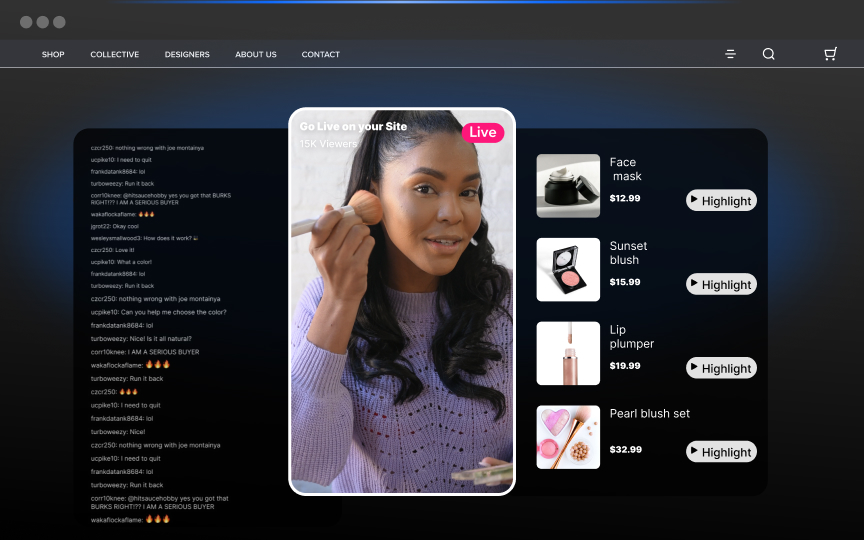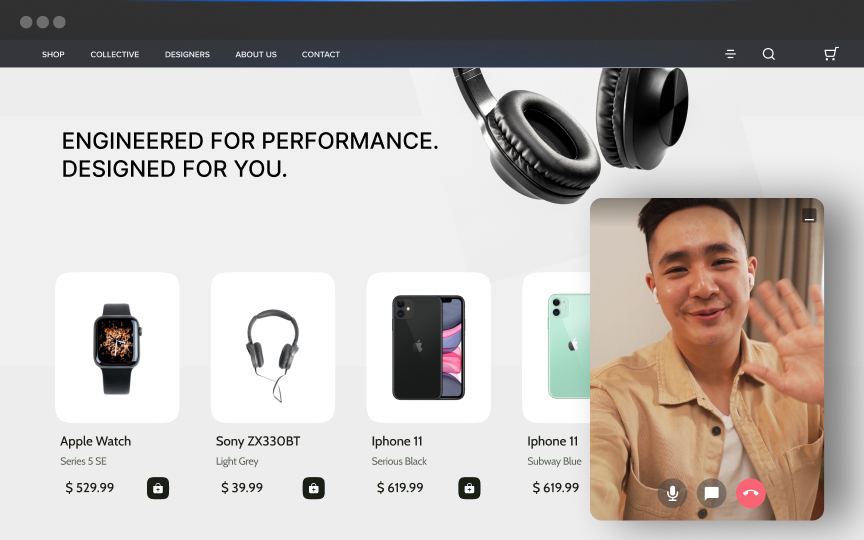Artificial intelligence (AI) is changing how businesses interact with customers, offering more personalized and engaging experiences. By leveraging algorithms and collecting user data, AI enables companies to tailor content, recommendations, and services specifically to individual preferences and behaviors. This helps enhance customer satisfaction and drive higher engagement rates.Implementing AI-driven personalization involves using various techniques like machine learning and natural language processing. These methods allow businesses to provide real-time content adjustments that match user preferences, such as those used by companies like Amazon and Netflix. It's not just about recommendations; it's about creating an experience that feels unique to every user.Aligning AI-driven personalization with marketing strategies can improve online store metrics significantly. Companies that make use of personalization report better customer retention and sales growth. For example, machine learning can help business owners understand what their customers really want, leading to more targeted and effective marketing campaigns.
Key Takeaways
- AI-driven personalization enhances customer satisfaction by tailoring experiences to individual preferences.
- Businesses can use machine learning to improve marketing strategies and drive better metrics.
- Real-time content adjustments create unique experiences for every user.
How Can AI-Driven Personalization Improve Online Store Metrics?
AI-driven personalization has the power to transform online stores by boosting key metrics like customer engagement and sales. By using advanced algorithms, retailers can offer tailored experiences that meet shopper needs and preferences.
What Are The Key Metrics Affected By AI-Driven Personalization?
AI-enhanced personalization impacts several vital metrics. Conversion rates often increase because customers see products and content that match their interests. This relevance reduces bounce rates and boosts average session duration.Customer retention rates also improve. Personalized experiences make shoppers feel valued, encouraging repeat visits. Additionally, average order value climbs as real-time recommendations suggest complementary products.Metrics like click-through rates (CTR) benefit from tailored content. Customers are more likely to engage with content that feels relevant to them. Enhanced customer satisfaction leads to positive reviews, increasing brand loyalty and traffic.
How Does AI Personalization Enhance Customer Experience?
AI personalization creates real-time, tailored experiences for each shopper. By analyzing user behavior and preferences, the system delivers product recommendations that are timely and relevant. This process helps buyers discover new products effortlessly.Content recommendations keep the shopping experience fresh. Homepages and category pages can adapt to each customer, showing relevance-dependent items. This applies across all touchpoints, whether a shopper is online or in-store.Customer engagement sees a significant boost as a result. Shoppers are more likely to interact with content that feels personalized. By catering to individual preferences, retailers can make every customer interaction meaningful, leading to higher satisfaction.For more on the effects of AI on customer experiences, visit Medallia's blog. Learn how IBM integrates AI-driven personalization in eCommerce.
What Are The Best Practices For Implementing AI-Driven Personalization?
Effective AI-driven personalization strategies require the right tools and technologies as well as strong data privacy and security measures. These elements ensure customer data is handled responsibly and personalization efforts yield the desired results.
What Tools And Technologies Should Be Used?
Successful implementation of AI-driven personalization involves various tools and technologies. Machine learning algorithms are central to analyzing customer data and preferences. Natural language processing (NLP) enhances chatbots and virtual assistants, making interactions more intuitive.Recommendation engines and collaborative filtering track user behavior and suggest relevant content. Segmentation based on demographic information and behavioral data ensures targeted marketing strategies. Using data quality management tools ensures accurate and reliable data collection.Content-based filtering methods help tailor content to individual tastes. Advanced personalization techniques, like generative AI for creating unique user experiences, are also gaining traction. For more in-depth insights about how AI personalization can boost customer engagement and satisfaction, visit this AI Personalization guide.
How Can You Ensure Data Privacy And Security?
Ensuring data privacy and security is paramount for building trust with users. Start with data encryption and secure protocols to protect user data from unauthorized access. Implement strict data privacy policies that comply with regulations like GDPR and CCPA.Focusing on data minimization limits the amount of data collected to only what is necessary. Regular audits and data quality checks maintain integrity. User profiles should include clear consent forms detailing how their data will be used.Adopting transparent data handling practices can mitigate privacy concerns. Using secure servers and regularly updating security measures prevent breaches. To explore more about balancing personalization with data security, this article on implementing AI for personalization offers practical tips.
How To Measure The Success Of AI-Driven Personalization?
Success in AI-driven personalization can be assessed by tracking specific metrics and interpreting collected data effectively. The goal is to understand how well personalization strategies impact user engagement, conversion rates, and overall business performance.
What Metrics Should Be Tracked?
Key metrics offer insights into the effectiveness of AI personalization. Conversion rates are crucial, showing how many users complete desired actions, such as making a purchase. Analyzing changes in revenue helps gauge financial benefits. Monitoring customer retention indicates long-term satisfaction and loyalty.A/B testing experiments compare personalized content versions, revealing preferences. Sales data analysis shows purchasing patterns while predictive analytics forecasts user behavior. Additionally, tracking user engagement, like click-through rates and time spent on site, signals content relevance and effectiveness.
How To Interpret The Data Collected?
Interpreting data involves understanding patterns and drawing actionable insights. If conversion rates improve, AI personalization is likely driving desired actions. Increased revenue suggests financial gains from personalized experiences. Consistent customer retention highlights effective user engagement strategies.Comparing A/B testing results helps optimize content based on user preferences. Analyzing sales data uncovers trends and predictive analytics aids in anticipating future behaviors. Companies can scale personalization efforts by identifying successful patterns. Tools like dashboards and reports make it easier to visualize data and implement changes for better results.For further reading on specific metrics and analytics, you can consult articles like AI-driven content strategy and guides on AI scalable content personalization found online.
What Are The Challenges In Implementing AI-Driven Personalization?
AI-driven personalization offers the promise of tailored experiences for users, but it comes with several significant challenges. Understanding these challenges is key to successfully implementing AI personalization in any business.
What Are The Common Pitfalls To Avoid?
One major pitfall is scalability. Although AI models work well on a small scale, scaling them up can be difficult. Ensuring that the system can handle a large number of users without a dip in performance is crucial.Transparency in AI models is another issue. Many AI systems operate as "black boxes," making it hard to understand how they make decisions. This can lead to a lack of trust and challenges in debugging.Over-personalization can also be a problem. When users feel like the content is too tailored and invasive, they may find it creepy or off-putting.Technical complexities related to data integration and system maintenance can be daunting for companies. Issues like data silos and outdated technologies can make implementation difficult.
How Can These Challenges Be Overcome?
Addressing scalability effectively requires robust systems that can distribute the data load evenly. Employing cloud computing can be a game-changer here. Many large-scale solutions use cloud infrastructures to efficiently manage growing data needs.Achieving transparency is possible by using explainable AI, which helps decode how AI arrives at decisions. This increases user trust and makes the system easier to manage.To avoid over-personalization, it's important to balance personalized experiences with general content. Testing different levels of personalization can help find the right balance.For tackling technical complexities, it's essential to invest in a skilled team and use up-to-date technologies. Collaborative tools can assist in integrating diverse data sources, making the entire process smoother.By focusing on these aspects, businesses can better navigate the landscape of implementing AI-driven personalization and ultimately succeed in offering tailored user experiences.
How Can AI-Driven Personalization Be Aligned With Marketing Strategies?
Aligning AI-driven personalization with marketing strategies can greatly enhance customer engagement and loyalty. This involves integrating personalized content into existing campaigns and utilizing customer feedback to refine these efforts.
How To Integrate AI Personalization With Existing Campaigns?
Integrating AI personalization into existing marketing campaigns starts with understanding current marketing goals and identifying where personalized content can add value. For instance, AI can analyze customer data to segment audiences and deliver tailored content through personalized email campaigns and targeted ads.Dynamic pricing is another strategy where prices adjust in real-time based on demand, supply, and consumer behavior. This encourages timely purchases and increases revenue. AI also enables cross-selling and upselling by suggesting additional products a customer might be interested in, enhancing the buying experience.Incorporating AI in email marketing involves sending personalized recommendations and offers, increasing open rates and engagement. Personalized marketing also extends to social media, where AI can schedule posts optimized for peak audience engagement.
What Role Does Customer Feedback Play?
Customer feedback is pivotal in refining AI-driven personalization. Feedback helps businesses understand customer preferences and experiences, allowing for more accurate content delivery. Collecting and analyzing feedback through surveys and reviews can identify areas where personalization efforts are succeeding or need adjustment.Customer feedback contributes to enhanced loyalty programs. By understanding what rewards resonate with customers, companies can tailor loyalty programs to offer more relevant incentives, boosting customer loyalty.Feedback data also aids in segmentation, allowing finer personalization in personalized email campaigns and other marketing channels. Regularly updating AI models with fresh feedback ensures that personalization efforts remain effective and relevant.
What Future Trends To Expect In AI-Driven Personalization?
The future of AI-driven personalization is set to bring groundbreaking changes. Emerging technologies and shifting customer expectations will shape how businesses interact with their audiences.
What Are The Emerging Technologies?
Generative AI is one of the most promising technologies. It can create personalized content by understanding user preferences, making interactions more engaging. For example, AI can generate custom marketing emails that cater to individual tastes.Hyper-personalization is another trend, which uses advanced data analytics to offer more tailored experiences. It combines information from various sources like behavioral, demographic, and transactional data. This helps businesses understand customers on a deeper level, improving engagement and satisfaction.AI in Human Resources is also growing. Personalized training programs and career plans can be developed by analyzing employee data. This ensures that employees receive the necessary support and growth opportunities.For more insights on these technologies, visit AI Personalization by IBM.
How Will Customer Expectations Evolve?
Customer expectations for personalization are increasing rapidly. They now expect real-time responses and highly relevant content. Meeting these demands requires businesses to use AI to analyze and predict their needs accurately.Transparency is also becoming crucial. Customers want to know how their data is being used. Ethical frameworks and bias mitigation are essential to ensure fairness and build trust. This is highlighted in the Future of AI-Driven Personalization in Tech article.As AI capabilities grow, customers will expect a seamless blend of online and offline experiences. Companies that leverage AI to personalize interactions across multiple platforms will have a competitive edge.
Frequently Asked Questions
Artificial Intelligence (AI) plays a crucial role in personalized user experiences across various platforms. The benefits, applications, and methods of AI-driven personalization are discussed below.
What are the key benefits of implementing AI in customer personalization?
AI helps businesses cater to individual preferences efficiently. It increases user engagement and satisfaction by delivering relevant content. For instance, platforms like Spotify use AI algorithms to suggest music tailored to individual tastes.
How can machine learning algorithms be applied to personalize user experience at scale?
Machine learning analyzes vast amounts of user data to predict preferences. This allows companies to offer personalized experiences in real time across different devices. For example, Algolia's guide to AI-driven personalization highlights the importance of consistency and ethical application.
In what ways does AI influence personalized marketing strategies?
AI aids in understanding user behavior and preferences to create targeted marketing campaigns. This deeper connection with the audience can significantly boost marketing effectiveness. Brands like Sephora use AI to recommend products that fit users' skincare needs and preferences.
How do neural networks enhance personalized content recommendations?
Neural networks process complex patterns in user data to suggest highly relevant content. This results in more accurate and engaging recommendations for users. For instance, Spotify utilizes neural networks to fine-tune its music suggestions.
What methodologies are involved in using AI for personalized online shopping experiences?
AI-driven personalization in online shopping involves analyzing user behavior, purchase history, and preferences. This helps recommend products that a user is likely to buy. Companies like Creaitor.ai utilize these methods to give users a tailored shopping experience.
How does artificial intelligence drive website personalization for individual users?
AI personalizes websites by modifying content based on individual user interactions. This can include dynamic content changes, personalized product recommendations, and user-specific offers. Such techniques ensure a unique browsing experience for each visitor, leading to higher engagement and conversions.
Unlock Exclusive Insights
By submitting this form, you agree to Firework's privacy policy and consent to receive personalized marketing communications. You can unsubscribe at any time.































